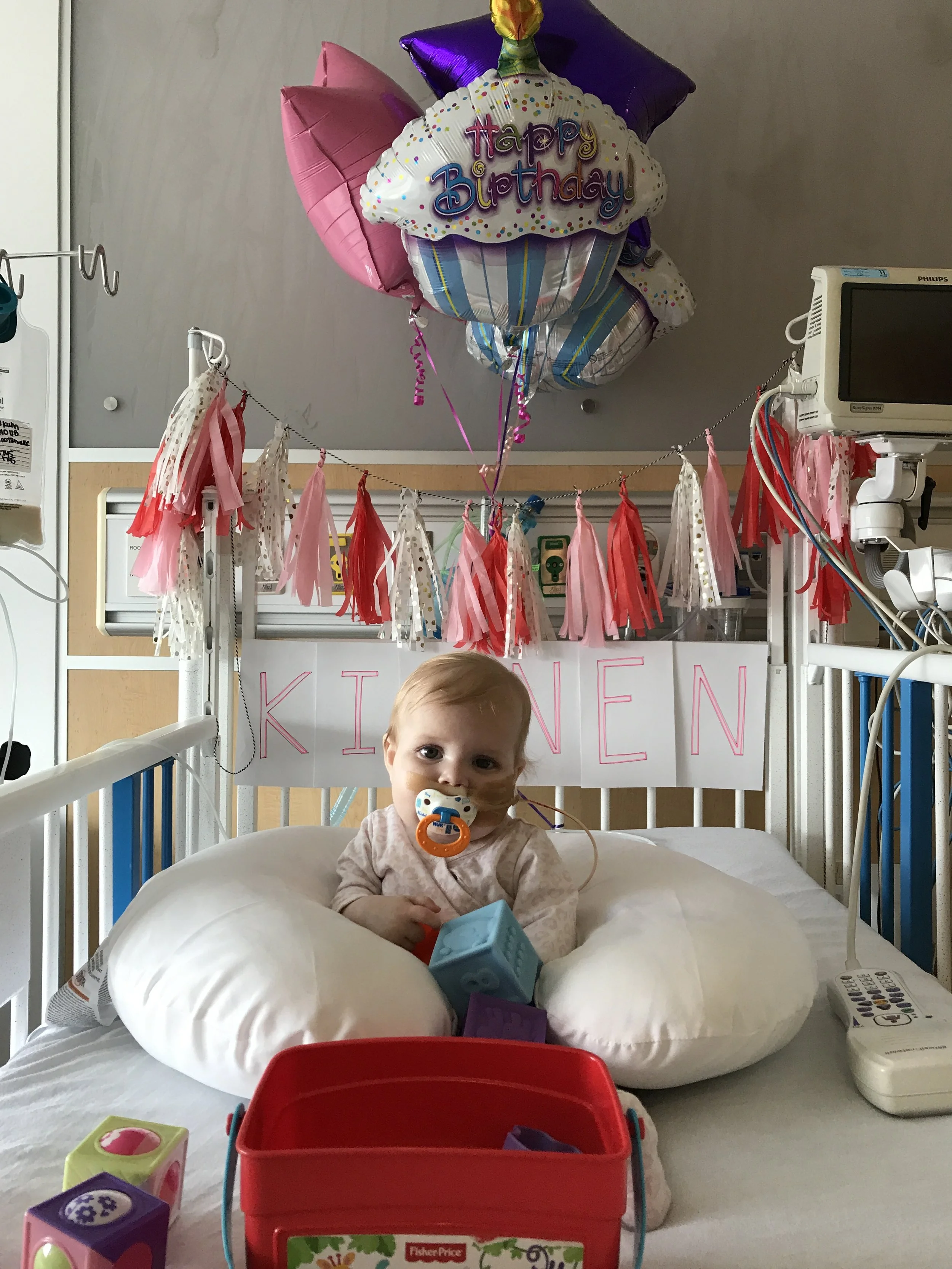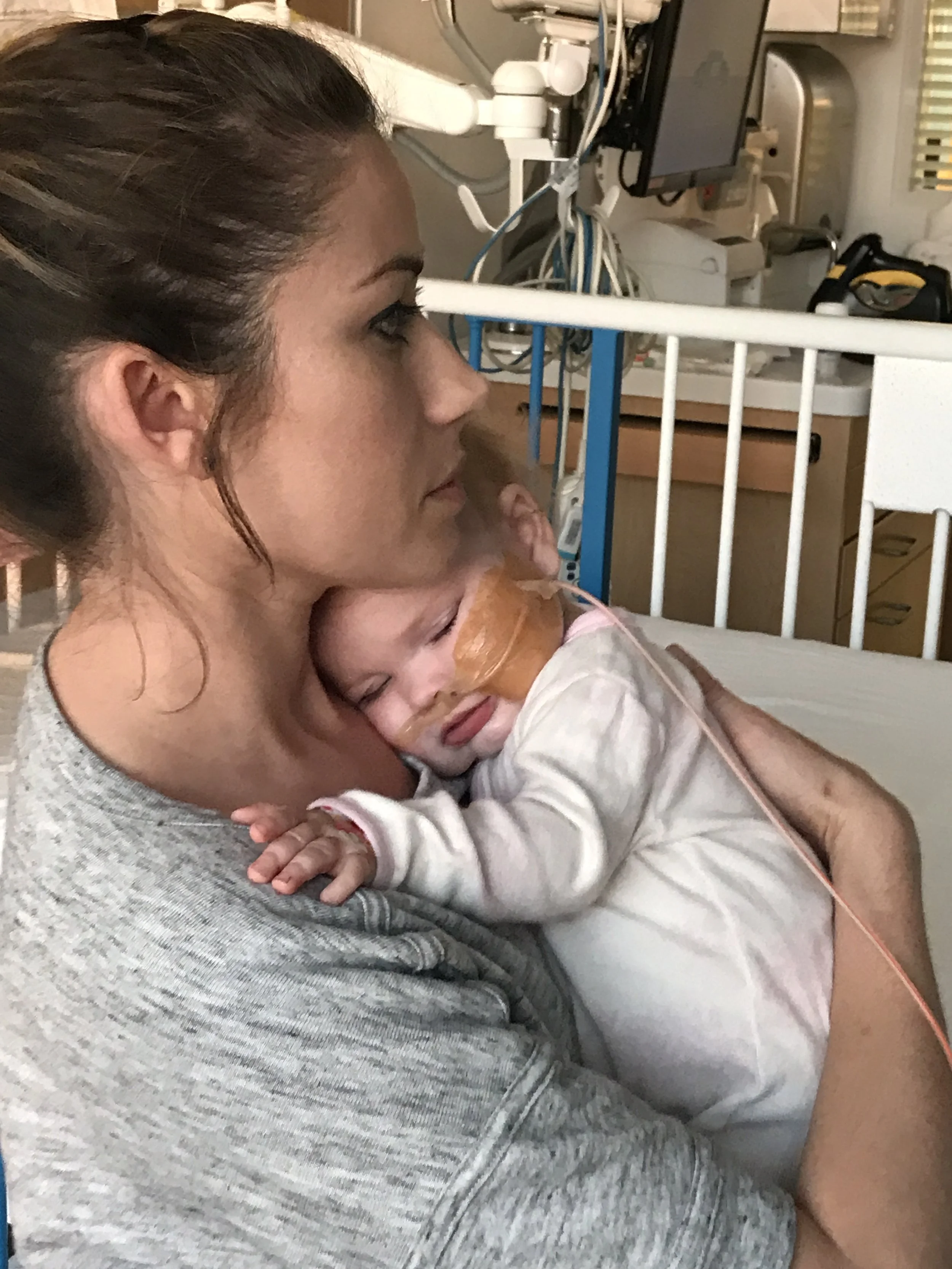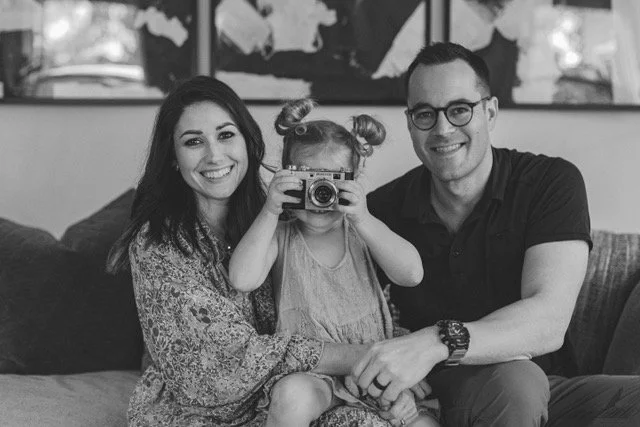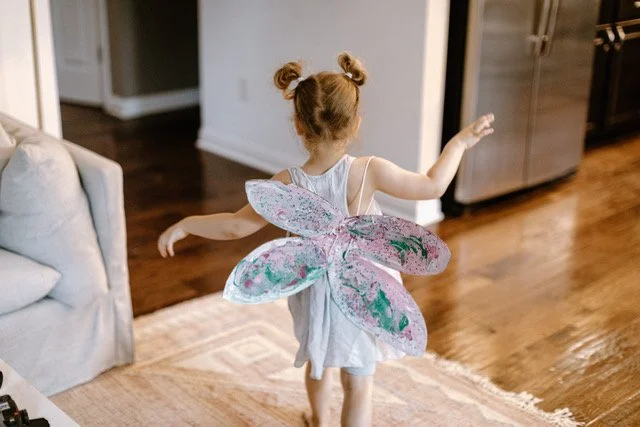Kinnen’s Story
night one at Nationwide Children’s Hospital (PICU)
Chelsea here! In 2017, my daughter Kinnen was diagnosed with a rare genetic disorder called Glycogen Storage Disease Type 1a (GSD1a). She was just a baby. 11 months old. in fact, her first birthday wasn’t spent with balloons and cake but recovering on the genetics floor of a children’s hospital, IVs in both arms and an NG tube delivering the nutrients her body so desperately needed and couldn’t regulate on its own.
We hung handmade streamers over her bed and thanked God she was still with us. But I cried the minute I could lock myself in that cold, sterile bathroom. I could be brave for her, but I was broken inside.
Several days before her birthday I had gone home for the first time in weeks. I made her tassel banner by hand, each strand. I hung it on the wall over her high chair. Surely we could go home for her birthday.
Twenty days earlier, we had rushed her to the ER in the middle of the night. She had been vomiting for hours, her breathing was labored, and then came the blood in her vomit. I knew in my gut we were losing her. It’s hard to describe, but I was never scared. Adrenalin took over and the Peace that passes all understanding took hold.
You may be wondering if this all came out of nowhere like a thief in the night. No. In fact, Kinnen had endured severe seizures between the age of two and six months old following each of her routine well check visits. She was always upset, abnormally tired and at six months old she stopped growing. Her tiny 13lb frame was pale and weak but her tummy continued to expand.
We spend the next 5 months in and out of various doctors appointments and no one seemed to know what was going on. Her symptoms just didn’t match up with her ultimate diagnosis so the answers kept getting missed. But we kept pushing and when she was rushed to Children’s in the middle of the night on May 20, it was an act of God getting us into the right hands for the first time. Hands we would never have reached otherwise.
That hospital stay revealed more than a bad virus. It cracked open the mystery of months of symptoms that hadn’t made sense: seizures, growth delays, an expanding belly, extreme fatigue. Our girl’s liver was storing glycogen it couldn’t process. Her cells weren’t receiving energy. Her tiny body was trying to survive a condition so rare that most doctors had missed it.
But finally, we had answers. And with them came a plan. We brought her home and began learning the ropes. Tube feeding, cornstarch formulas, round-the-clock glucose checks. Our kitchen became part pharmacy, part prayer room. I became an expert in dropping an NG tube and meticulously switching it from one nostril to another each month. A skill I hope I never need again, but if anyone does and I am near by, I’ve got your six.
We got into a routine. I had HOPE. But something else was off now. And then, at age four, a second diagnosis: autism.
Gut-wrenching? Yes. But also clarifying. I won’t say I was immediately relieved, although it was nice to have a direction to point us in. I was OVERWHELMED. If you have read our book, Finding Joy in the Journey, you are familiar with the sleepless nights, the intense routines, and then all the additional therapy needs and behavioral challenges that were piled on. Overwhelmed really doesn’t seem to encompass my feelings. To put in a less dramatic, Christian way, I wanted Jesus to come back and take us all home. I wanted the pain to stop.
Through her physical suffering and my own, I began to get sick through all of this, there was a still, small voice that kept calling me back. God. He still had enough of a hold on me that I could keep waking up and keep trying.
That’s the side of things that often get’s ignored. If a child is suffering, we focus on the child and healing that precious being. As a mother we don’t even think twice about ourselves…until is too late. We will break over and over again, telling everyone we are fine, even believing that to be true, because there is so much work to be done. I was falling apart on the inside and like so many other medical mamas, everything seemed tough as nails on the outside.
The rest of that is a story for another day, and can also be found in our book, but I mention it here to tell you that there are many facets we faced and still face as a parents to a medically complex child. Did you know that families like ours have an 80% chance of divorce? Between the stress and the financial pressures, it wrecks families over and over. We didn’t want to be one of those odds. So we leaned in.
We embraced the diagnosis and pursued help. The more we understood, the more we could fight for her. And that fight is fueled not by fear but by love, faith, and an unshakable decision to move forward together.
Raising a rare child has been the most challenging experience I have ever had. Yet in some strange ways, also most the rewarding. One of the rewards has been and continues to be, connecting with other families with GSD and Autism. Suddenly the burden we carry becomes lighter because someone else gets it.
So I want the next section of this piece to be somewhat educational in hopes to help even more see Kinnen’s story and understand her.
What Is GSD1a?
Glycogen Storage Disease Type 1a is a rare genetic disorder caused by a deficiency in the enzyme glucose-6-phosphatase. It affects the liver and kidneys, making it difficult for the body to store and release glucose which is our main energy source. In plain terms? It’s a metabolic disorder that messes with blood sugar, liver function, and energy production. This is why she tires easily, overheats quickly and can negatively impact her cognition.
Symptoms vary but often include:
Low blood sugar (hypoglycemia)
Enlarged liver
Growth delays
Elevated lipids
Lactic acidosis
There’s no cure (yet), but there is treatment. And there is hope. We have a lot of convos around this and her team is praying for options for her as she grows older.
Life with GSD1a + Autism
I have often wondered if there are any other GSD/Autistic people out there, or if my baby is the only one? I’d love to connect if someone out there shares the same.
The two diagnosis, merged, has been a rollercoaster. Kinnen is now primarily G-tube fed and closely monitored to prevent dangerous drops in glucose. Her days are structured, her routines are essential,m. She paints, she rides horses in therapeutic lessons, and she studies critters and birds from sun up to sun down.
We’ve learned that healing doesn’t always mean a cure. Sometimes it means joy in the middle of unanswered prayers. Sometimes it means clinging to one another while the world swirls—and finding peace anyway.
What Helps:
If you’re just starting this journey, here are a few things we’ve learned along the way:
Get rooted in faith. Before we made a treatment plan, we made a promise: we would not let this diagnosis break our family. That decision, our resolve, anchored us when nothing else did.
Embrace community. From hospital staff to prayer warriors to friends who sat on the floor and cried with us, we didn’t walk alone. You shouldn’t either.
Learn like it’s your job. Because it is. Find the specialists, ask the hard questions, take the notes, and advocate like only a parent can.
Choose joy. Not every day is good, but there is good in every day. Keep your eyes open for it.
What’s Next?
Research is progressing. There’s work being done on gene therapy, enzyme treatments, and better management tools for metabolic conditions like GSD1a. And while we pray for a cure, we live in today. Because today is worth showing up for.
If You’re In This Too
Maybe you’re reading this from a hospital bed or in the quiet of a late-night Google spiral, looking for answers. Here’s what I want you to know:
You’re not alone. You’re stronger than you think, and your child, just like mine, is still full of possibility! It takes a lot of time and a heck of a lot of grace, but this life is a beautiful one in it’s own, very unique way.
Reach out if you need a hand, a hug, a prayer.
With love and hope,
Chelsea (and Kinnen)





